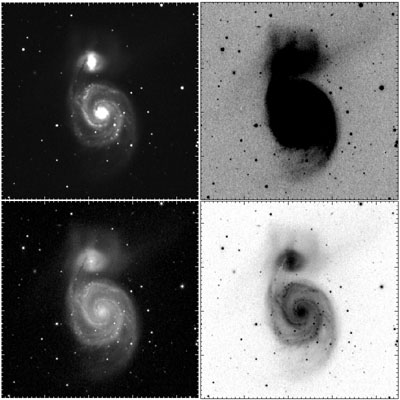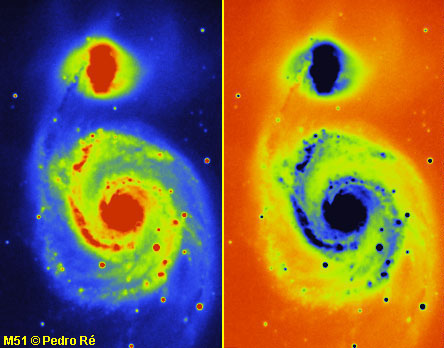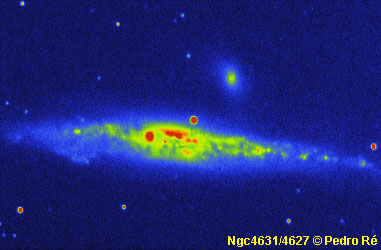INTERACTION GALAXIES
Interacting galaxies are among the most spectacular deep-sky objects. The effects of gravitational interference upon the
structure of the galaxies can be dramatic. A good example of interacting galaxies is M51 and Ngc5195. Both are spirals, each
about one-half the mass of our own Galaxy. M51 appears nearly face-on and badly distorted by the effects of Ngc5195.
M51 is one of the most beautiful galaxies that can be easily observed with backyard telescopes. It is in fact a highly
disturbed galaxy sometimes classified as irregular. Computer-generated models simulating the interaction of both galaxies indicate
that Ngc5195 has followed a boomerang trajectory that carried it past M51 millions of years ago. Now it can be found on the far
side of M51 and it is mooving away. The circular disk of M51 has been squeezed into an elipse by the gravitational pull of Ngc5195.
The encounter of these two galaxies stripped millions of stars from their parent systems and left them adrift in intergalatic space.
Anatomy of M51





Some intergalactic encounters like those of the spiral galaxies Ngc4567/Ngc4568 produce only mild disruptions in the
structures of the galaxies involved, while others, as the Stephan Quintet (Ngc 7317/20) and Ngc4631/Ngc4627
look profoundly dynamic and perturbed.





Ngc891
Ngc1055
Ngc2638
Ngc3628
Ngc3735
Ngc3877
Ngc4013
Ngc4096
Ngc4111
Ngc4206
Ngc4216
Ngc4244
Ngc4293
Ngc4298
Ngc4312
Ngc4388
Ngc4402
Ngc4438
Ngc4448
Ngc4526
Ngc4551
Ngc4564
Ngc4565
Ngc4607
Ngc4631
Ngc4656
Ngc4666
Ngc4691
Ngc4710
Ngc4762
Ngc5308
Ngc5690
Ngc5746
Ngc5838
Ngc5854
Ngc5864
Ngc7541
Ngc7814






























